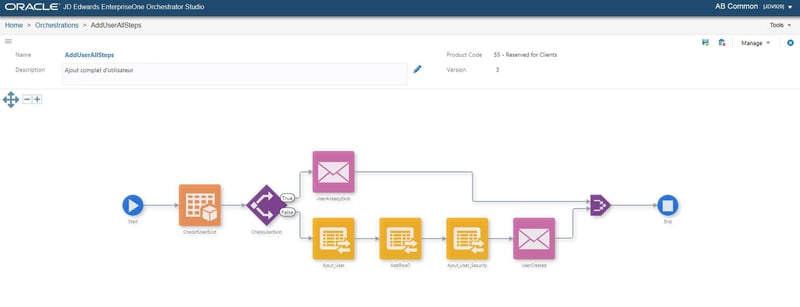What is JD Edwards Orchestrator?
The Orchestrator will transform the way you use JD Edwards. It will allow you to automate, execute, and exchange your data to put you on your way to an automated integrated system.
What is Orchestrator?
The Orchestrator is the perfect tool to automate repetitive tasks such as:
- Creating a user in JD Edwards (JDE);
- Verifying that the HTML instance functions well in the server manager;
- Deleting that instance’s cache inputs;
- Etc.
It can also be used for interfacing external software, websites, and the 4.0 industry. For example, you could connect to a currency conversion site to get the latest exchange rate. Another possible use would be to read the temperature from a sensor placed on a device in your assembly line, that would launch an alarm and request for service in JDE when required. It is the way to digital transformation.

The Orchestrator is comprised of micro-services there to help your employees. It will allow, for example, status updating, sending alarms, or even creating an entry straight into your system.
Since the Orchestrator can also be used to communicate with third-party systems, you will be able to automatize a wide array of tasks thus contributing, on the long-term, to the automation of entire business processes.

Finally, the Orchestrator is included in JDE standard licences. It comprises various components such as process recorder, notifications, white lists, schedules, connections, rules, cross references, service requests, orchestration, orchestration monitoring, file importing as well as the orchestration client, all of which I will detail below.
The Orchestrator Components
Let’s review the features of the various JDE Orchestrator components.
- Process Recorder > Record the steps to completing a task in JDE, translating into a service request within the orchestrator;

- Notifications > Sending a message with specific sending criteria and input parameters;
- White Lists > Define the list of authorized input values, such as hardware serial number. If that value is not listed, the orchestration will be suspended;
- Schedules > Define the occurrence of notification or orchestration;
- Connections > Configure connections to external resources such as external orchestrations or external REST services;
- Rules > Define the set of conditions used to assess the input from IoT devices to generate a true or false value;

- Cross References > Define relationships between input values and JDE EnterpriseOne values. For example, a device’s serial number could be associated to an asset number;
- Service Requests > Define task sequencing for a specific process in JDE EnterpriseOne applications or Java programs. There are seven types of service requests:
- Form request;
- Custom request;
- Data request;

- Message;
- Connector;
- Watchlist;
- Status.
- Orchestrations > Define orchestration inputs and add steps to a service request, a white list, a condition, and a crossed reference;
- The Orchestration Monitor > Monitor performances and exceptions corresponding to successful and unsuccessful orchestrations;
- File Importing > Importing .xml files or .zip files containing .xml files from a local source;
- The Orchestration Client > The EnterpriseOne orchestration client is a stand-alone web-based application that allows generating JSON input messages and test orchestrations.
Orchestrator Requirements
Installation requirements:
- A Weblogic server;
- The ADF Runtime component (that requirement no longer applies to versions 9.2.4 and up).
- A JDE AIS server;
- A JDE HTML server.
You will also be required to create a Weblogic server for the Orchestrator. It is also possible to use a WebSphere server with the 9.2.4 version.
The Orchestrator is available for EnterpriseOne version 9.0; 9.1; and 9.2. Available versions and components depend on JDE’s Tool Release.
|
Orchestrator Version |
Tools Release |
WebLogic Version |
Available Components |
|
5.1.x |
9.2.1.4 |
12.2.1 |
|
|
6.0.2 |
9.2.2.x |
12.2.1.0 12.2.1.1 12.2.1.2 |
|
|
6.1.x |
9.2.2.4 |
12.2.1.3 |
|
|
7.0.x |
9.2.3 |
12.2.1.3 |
|
|
7.1.x |
9.2.3.2 |
12.2.1.3 |
|
|
7.2.x |
9.2.3.3 |
12.2.1.3 |
|
|
7.3.x |
9.2.3.4 |
12.2.1.3 |
|
|
8.0.X |
9.2.4.X |
12.2.1.3 |
|
|
9.2.4 |
9.2.4 |
N/A |
|
At Createch, we developed the expertise to guide you through the implementation process of this powerful tool toward the automation of repetitive processes. We can help you undertake your digital transformation and launch your organization into the Industry 4.0 era, contact us!





